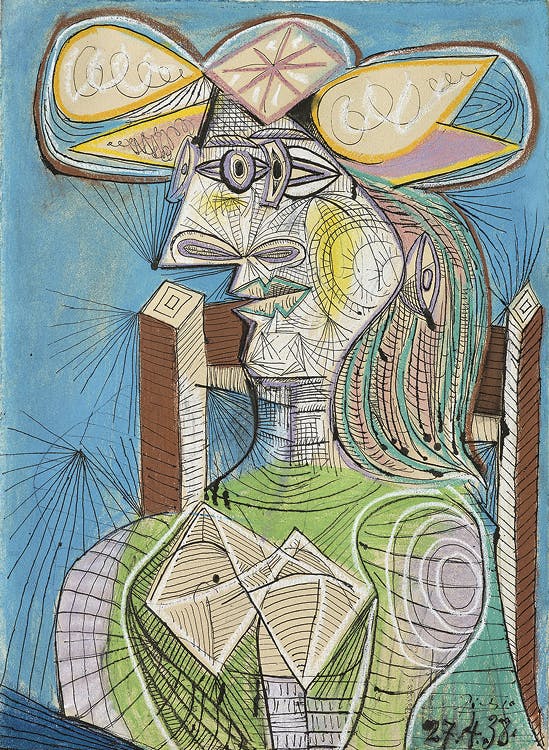
- Magazine Article
- Exhibitions
Exhibitions in 2020
A preview of this year's lineup, from Picasso to Phnom Da, printmaking to photograpy, African art to Marilyn Monroe

Seated Woman (Dora) 1938. Pablo Picasso (Spanish, 1881–1973). Pen, ink, gouache, colored chalk on paper; 76.5 x 56 cm. Fondation Beyeler, Riehen / Basel, Beyeler Collection, Inv. 72.5. Photo: Peter Schibli. © 2019 Estate of Pablo Picasso / Artists Rights Society (ARS), New York.
Paper, stone, silk, woodblocks, and Cleveland teenagers. In 2020 the museum is showcasing artists with distinct inspirations. “This year, more than most, speaks to artists who are makers,” says Heidi Strean, director of exhibitions and publications. “We’re focusing on artists who elevate their source material.”
More than 300 works are in Picasso and Paper, opening in May in the Kelvin and Eleanor Smith Foundation Exhibition Hall and Gallery. Picasso used many papers and spent decades investigating printmaking techniques on paper supports. “Many of these works were in Picasso’s studio when he died. Some of the pieces reached museum curators as late as 1990,” Strean says. “One thing I love is that this is not just a paper show, and it’s not just about Cubism. It’s about his whole career. Some of these works are personal, and that’s where the surprise is. The little tear-out pieces he would make are odd and charming.”
Cleveland is the only North American stop for this exhibition organized by the CMA and the Royal Academy of Arts, London, in collaboration with the Musée national Picasso-Paris. The show is by the same team that shaped the landmark Painting the Modern Garden: Monet to Matisse in 2015.

Jumping ahead to October, Krishna and the Gods of Stone Mountain: Early Cambodian Sculpture from Phnom Da and Angkor Borei is the first major exhibition about Phnom Da (“Stone Mountain”), the earliest known sacred site of Cambodia. On view in the Kelvin and Eleanor Smith Foundation Exhibition Hall, the show features the CMA’s great sculpture Krishna Lifting Mount Govardhan from Phnom Da—whose restoration is made possible by the transfer of missing pieces from Cambodia to Cleveland.
The eight gods once carved and featured at Phnom Da will be “reunited” visually through to-scale, interactive projections. Immersive, transportive audio paired with video will evoke the voyage to the site through the Mekong Delta. The exhibition will set a new museum standard for the use of mixed reality as a tool to connect visitors with art.
The first exhibition opening in 2020 is PROOF: Photography in the Era of the Contact Sheet, about the process used by photographers, such as Diane Arbus and Richard Avedon, before digital photography simplified image editing. This fascinating look at the outtakes of photo sessions featuring Marilyn Monroe, the Beatles, and Groucho Marx opens in February in the Kelvin and Eleanor Smith Foundation Exhibition Hall. For a look at how digital photography allows a contemporary artist to transmute images, the museum presents Signal Noise: Aaron Rothman at Transformer Station later in February. Rothman turns photos of the American West into sensuous images that hover between representation and abstraction.
Laura Owens grew up in Norwalk and spent many hours as a teenager studying the CMA’s collection. She returns for her first solo exhibition in northeast Ohio, a collaboration with high schoolers in the CMA’s Currently Under Curation program. United by the theme of time travel, the objects on display include new and existing work by Owens and pieces from the CMA’s education collection. Her show opens in June at Transformer Station.
Golden Needles: Embroidery Arts from Korea opens in March in the Arlene M. and Arthur S. Holden Textile Gallery (234). The show celebrates the inventive expression of women in the rigidly patriarchal Joseon society (1392–1910). Wedding gowns, social badges, wrapping cloths, and sewing tools combine with essays by women of the era to give voice to women who found empowerment in embroidery.
Also debuting in March is Ilse Bing: Queen of the Leica, surveying the career of the German avant-garde artist whose work appeared in the first modern photography exhibition at the Louvre, in 1936. After spending six weeks in an internment camp after Germany invaded France, Bing secured a visa to immigrate to New York City in 1941 and continued her photography there.
Later in March, the CMA presents the first exhibition of its wide collection of works on paper produced in Latin America. A Graphic Revolution: Prints and Drawings in Latin America in the James and Hanna Bartlett Prints and Drawings Gallery (101) features 48 works ranging from Mexican muralist Diego Rivera to Cuban-born Surrealist Wifredo Lam to Argentinian mixed-media artist Liliana Porter.

Second Careers: Two Tributaries in African Art opens in July in the Julia and Larry Pollock Focus Gallery (010). CMA objects from nine African cultures—male and female figures, masquerade costumes, a hunter’s tunic, and a prestige throne—are juxtaposed with works by contemporary African artists. For Strean, the show is a special opportunity to “combine historical objects from our collection with the work of new artists, lending all the artworks more vibrancy.”
In August the CMA presents the work of Gustave Baumann. The museum mounted the first show of Baumann’s woodcuts in 1918 and received 65 color woodcuts and 26 drawings by the artist from his family in 2005. Organized by retired curator of prints Jane Glaubinger, this year’s exhibition features one set of blocks and its resulting prints from 1926, Summer Clouds. “It took him a week to cut six blocks,” Glaubinger marvels. “Seeing the blocks and the proof together helps you appreciate what Baumann did—and he did it all himself.”
Strean thinks the upcoming year offers a bit of something for everyone. “One thing I am most proud of in the 2020 calendar,” she says, “is how well balanced it is between scholarly exhibitions and blockbuster projects.”

Cleveland Art, January/February 2020